Our boats
Our Festival wouldn’t be the same without the spectacular boats who visit. We invite scores of historic vessels to fill the harbour, re-creating the sights, smells and flavour of what was once an important, vibrant fishing port. Traditional wooden vessels, (from Brittany to Falmouth) are rigged with spars and tan sails and line the harbour wall. They then set out for an impressive parade of sail over the three days, a sight that stirs the heart of even the most hardened land lubber.
Boat Owners – if you would like to visit us in 2018 please send us your details using this form. Please give us details of your boat including dimensions and the type of berthing required. Please let us know about any special requirements your boat may have and preferably include a phone number we can get you on too.
Select to see if you want to see the boats who have confirmed for this year, or last year’s vessels.
Previous years' boats
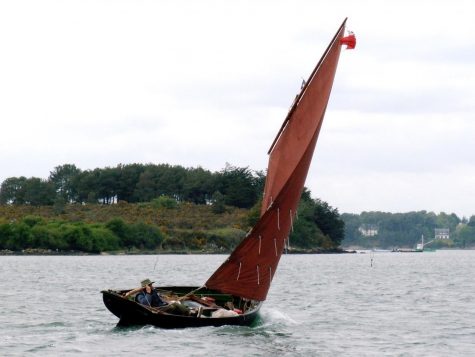
Abel Dro
Abel Dro is an Ilur design by François Vivier – based closely on traditional Breton inshore fishing boats. The plans were originally produced for the magazine Le Chasse-Marée in the 1980s, as a boat for home building. Since then she has become the most popular of Vivier’s designs. Avel Dro is Breton and means wind shift. She was professionally built in Cancale, Brittany by Les Charpentiers Reunis in 1994. Roger Barnes has owned her since 2004 and uses her extensively for sail and oar cruising along the French and UK coasts, sleeping aboard under canvas.
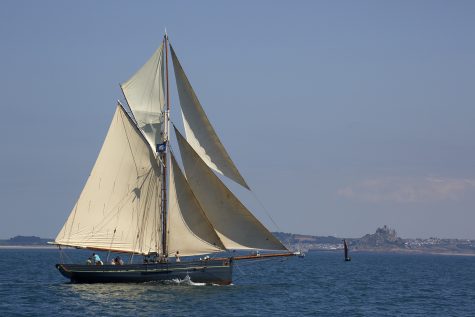
Agnes
Agnes was built by Luke Powell, who followed the lines of the original 1841 pilot cutter from the Isles of Scilly. She had a long working life back then, ending her days under Capt. Stephen Jenkins, whose grandsons Alf and Harry helped launch the new boat in 2003. Her dimensions are 46ft on deck, 13’ 3’’ beam, 8’ 6’’ draft and a displacement of 26 tons. Agnes was originally built for an American and sailed across the Atlantic for the first few years of her life. Owned by Luke and Joanna Powell, she now operates as a charter vessel from Cornwall.
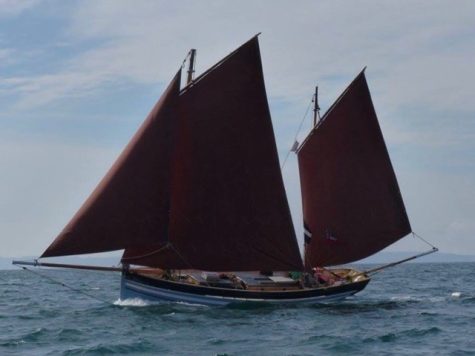
Alert of Fowey
Alert of Fowey is a replica of an 1835 smuggling lugger, designed and built by Stirling and Son at Morwellham Quay, Devon. Following her launch in 2007, Alert sailed to Iceland on her maiden voyage. Since then, she’s been owned by Tim Marchant and based from the River Tamar. She is 37 ft, however, overall length is 65 ft. Notable contemporary design features are the wide boards of clinker planking up to the whales, which are of oak, carvel and thicker. Relatively full forward sections above the waterline lead to an upright stem, while a deep and pronounced forefoot is the culmination of a fine entry below the waterline. The 11′ 3” beam of the vessel is comparatively wide, which gives a beam to waterline length ratio of less than 3:1. This lends the boat stability and an ability to stand up to a large rig. The long run leads right up to the tuck of the lute stern, which overhangs the sternpost by approximately 4 ft. The keel is straight and her depth of draught (6′ 3”) reflects her Westcountry origins. She is built of larch on oak with lead ballast and copper and bronze fastened throughout.
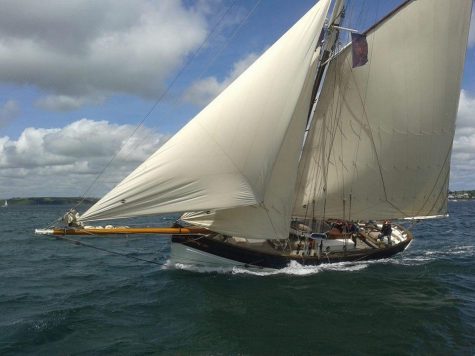
Amelie Rose
Amelie Rose is a replica of a 19th Century wooden Pilot Cutter and was launched in 2009. She is licensed to carry up to 10 passengers. Built by Working Sail in Cornwall using traditional methods, she has worked as a successful holiday and training charter vessel and in 2012 starred in “The Hungry Sailors” on ITV. She is based on the Beaulieu River in the heart of the New Forest and sails the English Channel, from the Solent to the Isles of Scilly, Channel Islands and Brittany.
This year Amelie Rose is being used as a project to tackle sea plastic pollution. This is a fantastic non-profit project. For more information and to support the team, take a look at www.cleanseasodyssey.org. Nick and Rebecca say ‘We started on June 2nd and are sailing Amelie Rose with a volunteer crew anti-clockwise around the channel. On the way we visit ports, harbours and festivals to meet with local people, do some beach cleans and film stories about plastic pollution in the area and what local people are doing about it. The project is about raising awareness that plastic pollution in the sea is not just a problem in far away oceans but also in our own seas. Findings are all published.
At Sea Salts, Amelie Rose and her crew will welcome folk aboard so they can look around the exhibits and information boards and chat about the real threat of plastic pollution.
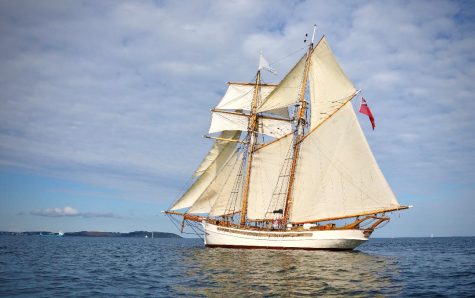
Anny of Charlestown
Anny of Charlestown was built as a fishing vessel in Denmark in 1930, then under German control during WWII, finally ending her working life in the early 70’s. In 1972, she was converted into the topsail schooner and travelled the world, including Australia and the Caribbean. In 2019, Anny was purchased by Charlestown Harbour and sailed back from Germany. As the harbour’s flagship, she now completes a busy season of day sails, residential voyages and special events. Her dimensions are 94ft LOA, 16ft beam and 9ft draft.
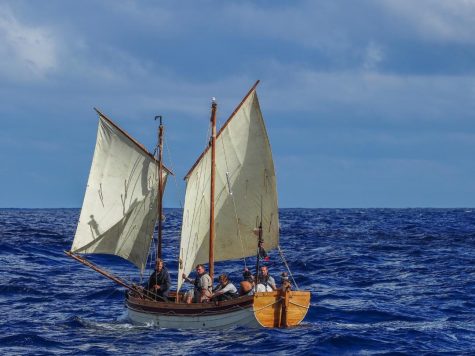
Bounty’s End
It would go down in history as the Mutiny on the Bounty. In short, Captain Bligh and a handful of loyal men were forced into a tiny open boat and left to die. Instead, they managed to navigate 4000 mies to safety, through some of the world’s most remote and unforgiving seas. This remains one of the greatest survival feats in British history. Setting out to recreate the passage, a crew of nine men made the journey in a replica open 23ft wooden boat, built in Richmond, London by Mark Edwards MBE. Using traditional navigation and surviving off the same meagre rations as Bligh, the men were cast adrift 35 miles to the south of Tofua, near the Kingdom of Tonga. Their mission, to survive and safely navigate across 4000 miles of open ocean to Kupang, Timor. The group were led by Anthony Middleton, SAS Who Dares Wins frontman. However, British yachtsman, Conrad Humphreys, who has circumnavigated the world three times, was the Sailing Master of Bounty’s End. They all faced a never-ending struggle, where extreme hunger, fatigue, illness, conflict and stormy seas threatened to engulf their tiny boat and end their hopes of reaching Timor safely. The Bounty Project is now an exciting and inspiring collaboration between Conrad and The Island Trust, to support young and disadvantaged people with life changing voyages at sea.
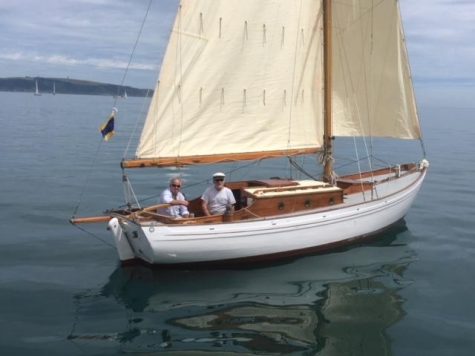
Caupona
Caupona was launched in 1939 and is one of the early pre-war Laurent Giles Vertue designs, the 8th boat of only a handful built to this design. She is currently based in Dartmouth and owned by Richard Gregson. The design proved so successful that they altered it slightly with increased freeboard and a doghouse, to give more interior space and volume. Examples of these Vertues have circumnavigated the globe, one of the most well known Vertues, V35, was sailed across the Atlantic from Falmouth to New York by Sir Humphrey Barton, founder of the Ocean Cruising Club. They have an unusual ‘slutter’ rig, a combination of sloop and cutter, which gives numerous sail combinations for different weather conditions.
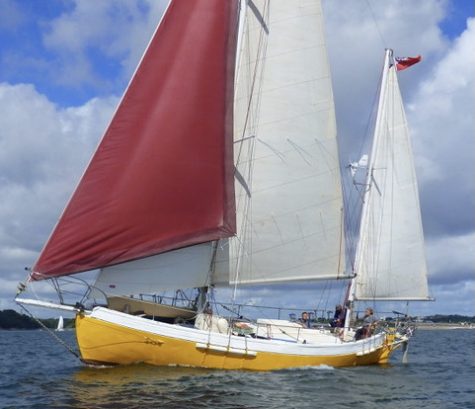
Dandy
Dandy has a ferris cement hull and is an extremely capable Norwegian type double-ender. She is Marconi ketch rigged, capable of being solo sailed and is around 36ft on deck. Owned by the artist Richard Sowman, she was used as a live-aboard for a decade and sailed extensively in France and Spain. Currently moored is Saltash, Devon.
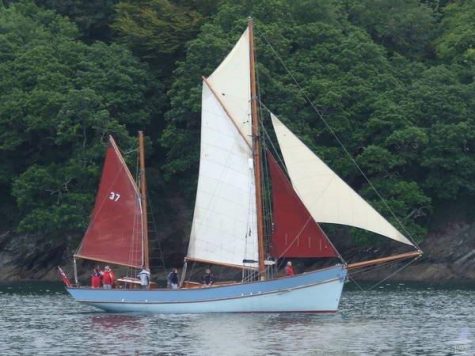
Donna Capel
Originally named Françoise Helene, Donna Capel has a fascinating history. She was constructed under German licence in Ostende, Belgium, during 1943/44. The oak was pre-war timber, originally destined for a boat about 90ft in length. This explains why, at 52ft, she is so heavily timbered. She was the last of the sailing trawlers built that worked out of Ostende during the war. Though, the first to be fitted with an inboard engine. Fished off the Belgian coast until the late 1950s, the record fish caught on one trip was 22 tons. She was then bought by Mousehole’s Howard Capel and towed by trawler from Belguim to Brixham. Here she was renamed Donna Capel after his wife and given the new registration number BM142. Mr Capel used the boat for trawling until 1970, when Terry Heard (Gaffers and Luggers) purchased her in Newlyn and took her to Mylor Bridge. Terry passed away before he was able to restore her, though she was restored by Martin Heard and managed Brest and Douarnenez in 1992. She was then bought by John Davison in 2000. With a strong-back and tarpaulins laid on, she spent the next six years untouched at Mylor Bridge. From 2006 to 2009, she was rebuilt and now sails as a stunning 16 meter Gaff Ketch, with 4 meter beam, 2 meter draft and is 40 tonnes in weight. She’s now based in Falmouth.
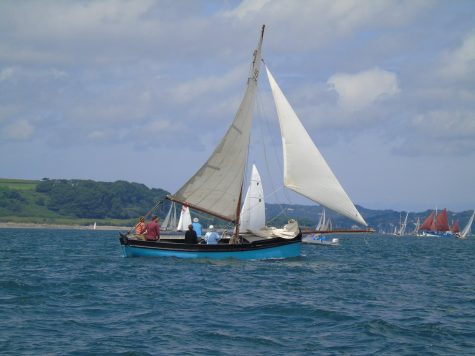
Edith
Edith is a Polperro gaffer built circa 1890, one of the oldest boats attending. She worked as a fishing boat (FY92) until 1923 by a fisherman called William Curtis. He had a daughter ‘Edith’ who the boat was named after. From 1923 until the late 1980s, she was owned by the Ferris family in St Mawes who used her as a sail training boat. Restored in the 90s by Richard Toyne of Falmouth, she was then used for five years as an oyster dredger before sold to Mal Stone.
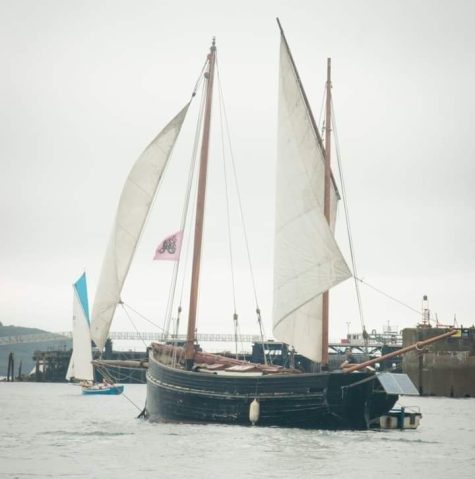
Eileen
Eileen is a 42ft 1920 Looe lugger and (along with Guide Me) was one of the last five boats still working out of Looe in the late 1960s. Being a late lugger, she is not as fine lined as earlier boats, therefore, doesn’t sail as close to windward. She makes up for this with ample internal space. We’re also told, once her particularly large “iron tops’l” is hoisted, they generally make it in time to catch last orders.
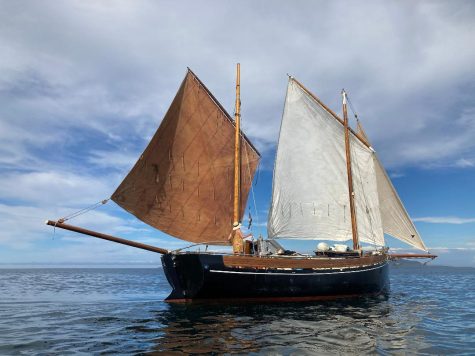
Eleanor B
Eleanor B was built at Bristol Marine in 2002 of rolled steel plating to the classic lines of an Alan Pape design. She is a replica of a Looe Lugger, based on the West Country lugger TALISMAN FY242 built in 1898.
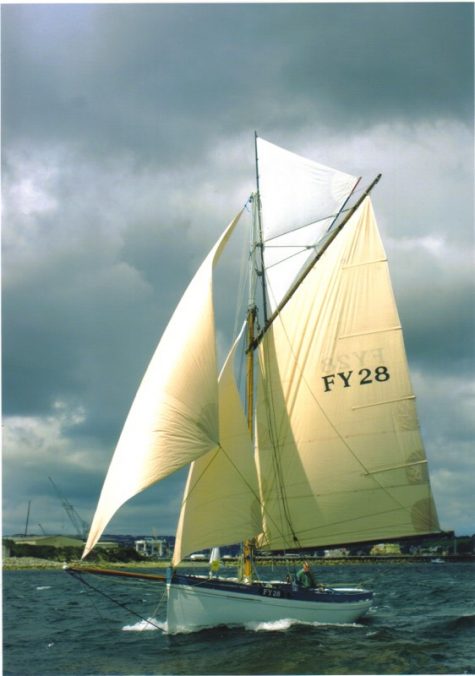
Elizabeth Mary
The Elizabeth Mary was built by Pearce of Looe in1908, for the Oliver family. She measures 26ft on the waterline. She fished out of Polperro for years, registered as FY28. She carries the traditional Polperro Gaff Rig with a loose footed main. She had various owners and was used for dredging oysters in the Fal for 10 years. Trevor Vincett, from Dartmouth, bought her and sailed her in local regattas, where she gained a reputation as a fast boat. Boat builder, Julian Burns owned her for a while before she passed to John Moody who partially restored her in his Salcombe boat yard. The present owner, George Dart, first saw her in Moody’s woodyard and persuaded John to part with her. He took her to Peter Williams’ Boddinick boatyard for re-planking and spent two years completing the restoration himself. She appears on the front cover of Ian Heard’s ‘Classic Boats of the West Country’, and also mentioned in ‘The History of The Falmouth Working Boat’.
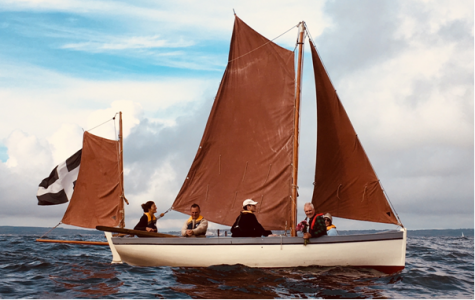
Ellen
Ellen is an engineless Gorran Haven Crabber, one of four historic vessels that form part of the Cornish Maritime Trust. She was built in 1882 by Dick Pill for the Willmott Family, is 17 ft, a beam of 6ft and a 2’ 6” draft. Her lines and spritsail rig are specific to Gorran Haven. She’s reputed to be the fastest original Gorran Haven Crabber ever built, though there’s two new ones based in the Carrack Roads. She’s certainly the oldest! By 1900, she was being fished by the Billings brothers, Dick and Andrew, who moved her to Flushing as there were too many Crabbers in Gorran Haven! She’s now permanently based in Mousehole, trailered to certain events and there’s a plan for adventures further afield. There is an active community that sail and maintain her, generally based from Mousehole. Membership and sails are very affordable.
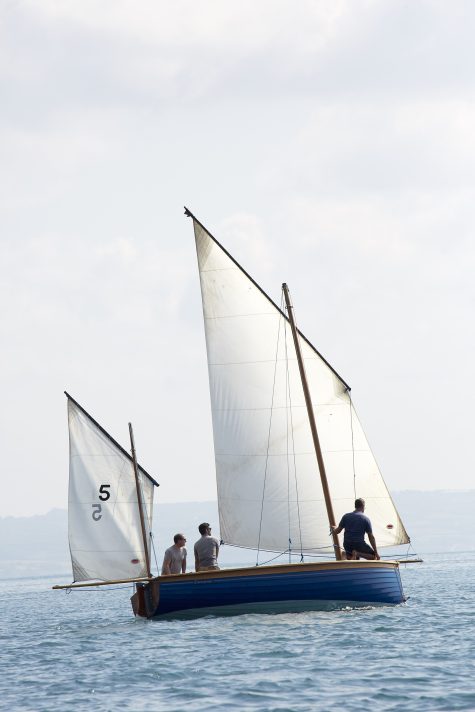
Enterprise
Enterprise is a graceful little 17ft Beer Lugger and was built with mahogany on oak in 2003. She has a 1956 Stuart Turner 1.5hp inboard engine and owned by Justin Adkin. Based from Beer.
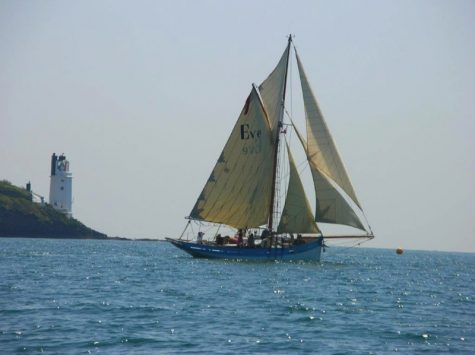
Eve of St Mawes
Eve owes her heritage to the Pilot Cutters of the Isles of Scilly. She’s a rugged, versatile craft, built to withstand the rigours of the Western Approaches in comfort and safety. These little ships were meant to be fast, weatherly and immensely strong. Traditionally constructed in 1997 by Luke Powell, she has a sense of history within her solid timbers and certainly built to last. She’s been admired, photographed and written about countless times. Under full canvas from overhanging boom to bowsprit cap, she becomes a 51ft Cutter, able to set five sails, keeping experienced sailors on their toes. Eve creates quite a spectacle around the small ports and harbours of Cornwall, Brittany and the Scillies and is owned by Classic Sailing, St Mawes, Cornwall.
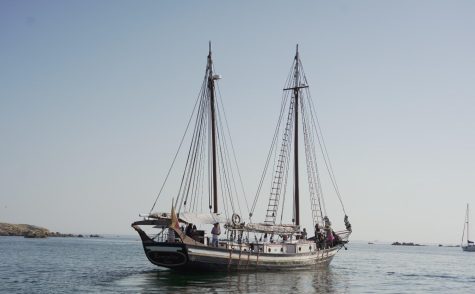
Evangelina
Evangelina was built is 1912 and we’re told has a fascinating history. She is a 62ft Goleta, based in Rianxo, La Coruña (Northwest Spain) and owned by Silva Pineiro.
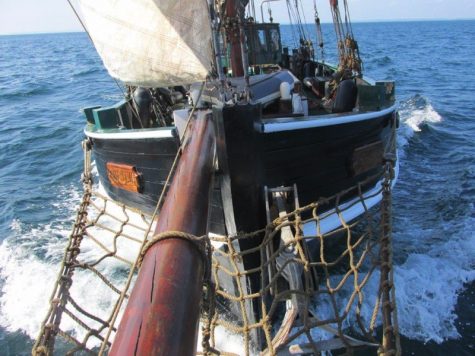
Freya
Freya is 15m long with a beam of 4.5m and draws 2.5m. She was built during the Second World War on the Baltic Sea in East Germany and worked as a fishing boat for most of her working life. Once retired from fishing, she was converted to Gaff Rigged and coded for chartering around Netherlands and the North Sea. She is now a cruising liveaboard, owned by Andrew Mccloud and kept at Millbrook, Cornwall.
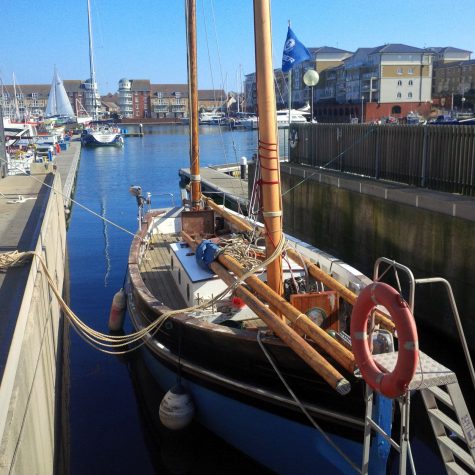
Girl Sybil
(PZ 595) was built in Porthleven in 1912 by the boat building firm of Kitto. She is 35ft, plus an eighteen foot bow spirit. Originally named the Patricia, she worked out of Newlyn as a pilchard driver. Originally a sailing boat, later motorised with wheelhouse added. Early skipper was Bob Vingoe (GH). The Patricia would have been renamed Girl Sybil when the boat was acquired by the Vingoe family of Newlyn. The owner named the boat for his daughter. His daughter was the manageress of the Stevenson Grocery shop in the Strand and later married Arthur Gribble. She acquired the boat on the death of her father in the mid 1930s. He died on the boat at sea. The boat was then sold to the Stevensons who retained the name and continued to work her as a pilchard driver throughout the war years. The fishing boat PZ 476 Margaret was towed in by Joe Carr, her engines caught fire at Lamorna in 1940, the crew were saved. Billy Stevenson joined her crew when he left school in 1943, aged 15, when the boat was engaged in pilchard fishing. Bobby Jewell worked on the boat at one time, fishing for pilchards. She is now owned by Louis Goddard.
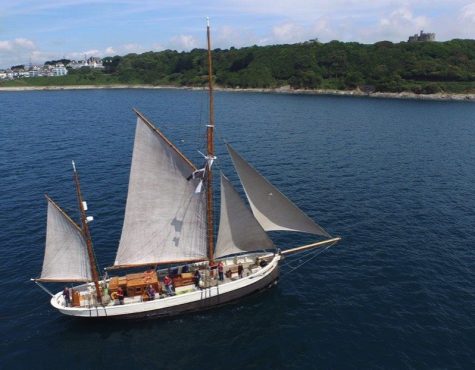
Grace
Grace is a 1925 wooden Danish top-masted Gaff Ketch, 77ft in length and originally built for fishing. She is owned by the pioneering Falmouth based mental health charity, Sea Sanctuary. The first of their kind in UK waters (and possibly the world!), Sea Sanctuary delivers programmes designed to improve people’s mental health whilst sailing amidst Cornwall’s stunning coastal environment.
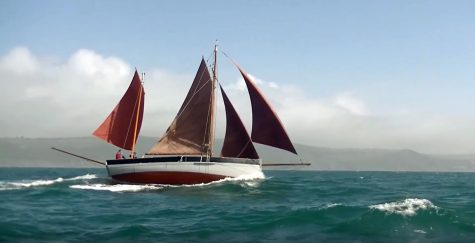
Guiding Star
Guiding Star is a Looe lugger built in 1907 by James Angear for Thomas Soady to fish for mackerel, pilchards and herring off the coast of Cornwall. She was one of the last Looe boats to be designed as a pure sailing boat. She has a finer hull and sails faster than boats built only three or four years later, after petrol engines were introduced. Guiding Star fished for nearly thirty years but was sold during the depression of the 1930’s and converted into a yacht in 1937 at Uphams yard in Brixham. Her first owner was a surgeon from Torquay. From 1960 to 1989, Guiding Star was owned by Brigadier John (Jack) Glennie, who sailed her all around Europe including the Baltic Sea. She was then substantially rebuilt in the early 1990’s by Barry Jobson and Jacquie Gillespie, who sailed her to the Caribbean and back and took part in many classic regattas. Her current owners are Paul and Sue Eedle.
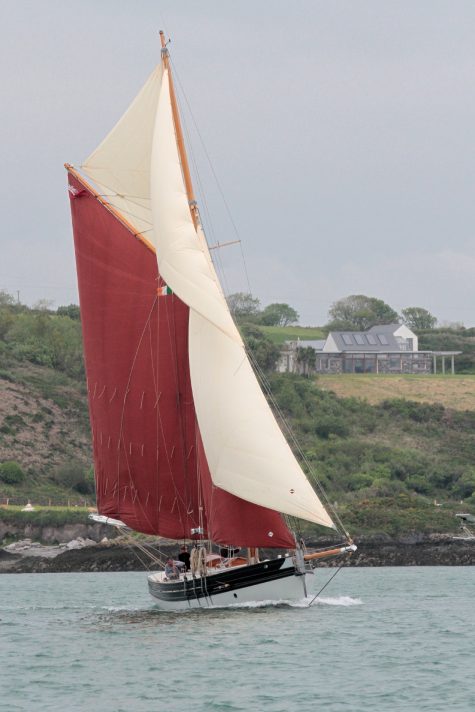
Holly Mae
Holly Mae is a 35ft gaff cutter, traditionally built by Joff Rorke of larch planking on oak frames. The design is inspired by the West Country work boats of around 100 years ago, though there are influences of Falmouth Working Boats, Falmouth Quay Punts and Pilot Cutters. She was built in Gulval and has crossed the Atlantic, spending a winter in the West Indies and several seasons exploring the Baltic.
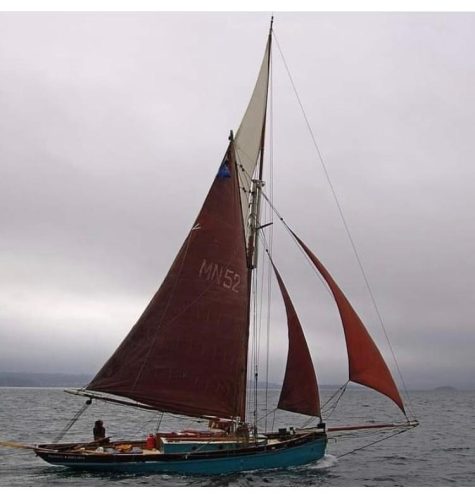
Ibis
Ibis is an East Coast Oyster Smack of timber carvel construction with pitch pine hull and an inboard diesel engine by Kubota. She was originally built in 1888 for The Whitstable Oyster Company and worked the oyster grounds for about 30 years. When bought by her previous owners in the 1970’s Ibis needed extensive work and it took seven years before she could go for her first sail. Since then, she has been kept in sailing condition and in 2003 completed an Atlantic crossing where she won the Spirit of the Regatta Cup in Antigua. Today, she lives in Penryn and is used to ship Petrel Rum to events around Cornwall, Isles of Scilly and Brittany. She is owned by Elle Demaus.
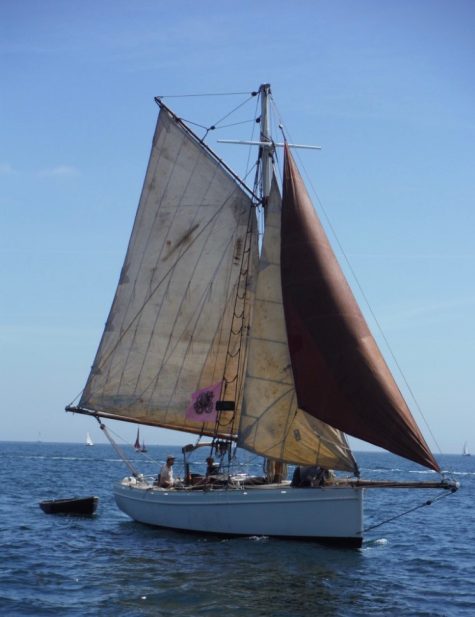
Isis
Isis is a 32ft gaff rigged cutter originally built in Fowey in 1909 and based on the lines of a Falmouth Quay Punt.
In the mid 70’s she sailed from the Hamble to Sri Lanka and then to Singapore. Here, she was sadly badly eaten by termites. A Cornish man, Llewelyn Baker from Porthlevan bought her and proceeded to start a four year rebuild. In the early eighties, now freshly built in a Malaysian hardwood called Chengal, Isis set sail again for Cornwall via the Cape of Good Hope. Voyaging for four years without an engine, she finally arrived in Porthlevan. Llewelyn then decided to set sail for the Mediterranean where he and Isis voyaged for ten years. More recently, she has undergone a light refit and now has an engine installed. Isis has many a tale to tell and she will captivate you. Now owned by Richie Morris and based in Penryn.
In the mid 70’s she sailed from the Hamble to Sri Lanka and then to Singapore. Here, she was sadly badly eaten by termites. A Cornish man, Llewelyn Baker from Porthlevan bought her and proceeded to start a four year rebuild. In the early eighties, now freshly built in a Malaysian hardwood called Chengal, Isis set sail again for Cornwall via the Cape of Good Hope. Voyaging for four years without an engine, she finally arrived in Porthlevan. Llewelyn then decided to set sail for the Mediterranean where he and Isis voyaged for ten years. More recently, she has undergone a light refit and now has an engine installed. Isis has many a tale to tell and she will captivate you. Now owned by Richie Morris and based in Penryn.
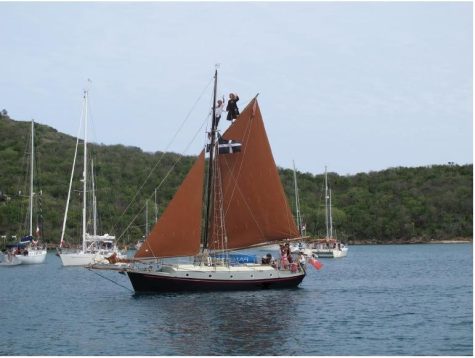
Island Swift
Island Swift is a 35ft Gaff Cutter (Wylo II), designed and built in 1996 by Nick Skeates and John Richardson. She’s one of the few examples of a modern gaff rigged cruiser, designed to sail around the world. She is easy to manage, safe as well as beautiful and owned by JoJo and Simon Pickering of Penzance. The family have sailed across the Atlantic to the Caribbean, via Portugal, Spain, Maderia, Canaries and Cape Verde. JoJo comments, ‘she’s a low tec boat, we do not have a fridge, radar, chart plotter or shower and we love using our lead line, Walker’s log and sextant’
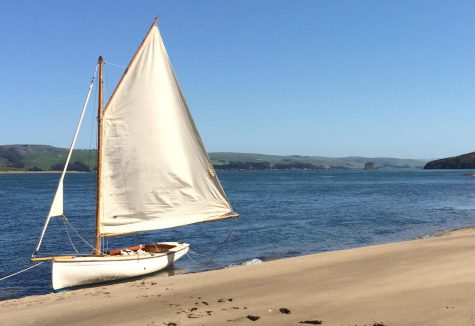
Jimbob
Jimbob is a GRP 16′ 6” (LOA 18′ 4”) Saltern’s Tela, she’s three-quarter decked and a is gaff rigged day sailor moored on St Michael’s Mount. Her design follows the lines of a 1911 ”seaker” boat named ‘Tela’, that worked out of Barry Harbour in the Bristol Channel. These were smaller versions of the famous Bristol Pilot Cutters and would put out into the Bristol Channel with a pilot on board, to meet incoming ships. Clearly the fastest boat out to the ship would get the pilot on first and earn the pilotage fee. Tela was apparently the fastest of the seeker boats, working up to 10 miles offshore. The modern class was developed by Chris Libby who created a mould from the original Tela in Penryn Bridge Boatyard, Falmouth. Jimbob was then built by Salterns Yard, in 2005. In 2012 the moulds were moved to Collars Spars in Oxfordshire where the boats continue to be produced. These pretty boats have a shallow draft (14″) with a centreplate, making them excellent river and estuary boats. With a reasonable weight of 540kg and a 50% ballast ratio and protective decks, they are capable of coastal passages. They are easy to handle single-handed, but can also take 4 people with comfort. They are very stable with good performance in light breezes, as well as having the capability to handle well in a blow. Owned by Paul Elliott in Marazion.
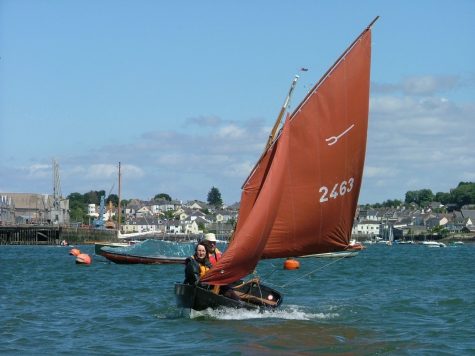
Julitta
Julitta is a Pooduck skiff class lugsail dinghy, designed by Joel White and based on a workboat from Maine, USA. She is plywood and epoxy construction and was built at Totnes in 1993. Her specs are 12’8’’ LOA, 4’5’’ beam, 8’’ draft and a 84 sq ft sail area. She’s owned by John Scott.
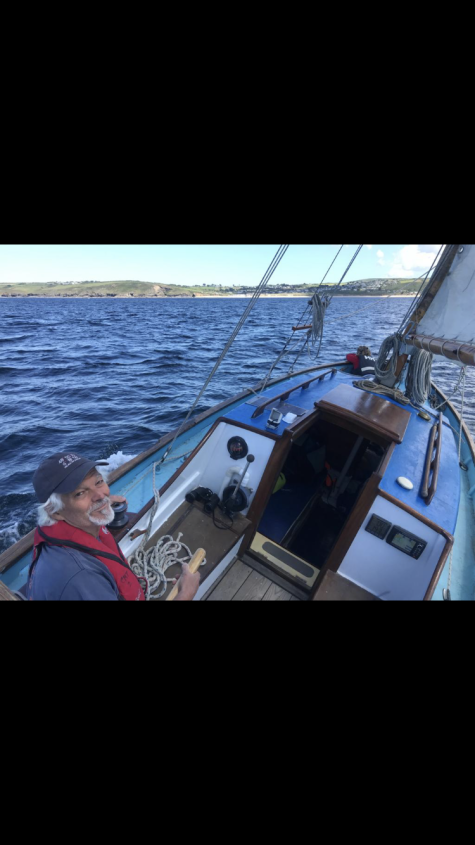
Juno
Juno is a 23ft 1980’s fiberglass cutter built by Terry & Martin Heard of Mylor. She is owned by Jim Wilkinson and sailed out of Penzance. With a gaff rig, she’s very capable, as well as a beautiful traditional looking vessel.
Katla
Katla, owned by Aidan Begbie, is a 26ft Gaff Cutter. She was built in 2006 in Portugal by Martin Lund and is of the Wynfall design by Mark Smaaklers. She has made two Atlantic crossings to and from the Caribbean and has recently been brought back to life in Penryn.
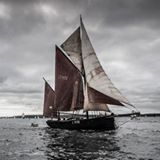
Keewaydin
Built in 1913 by G and T Smith in Rye, Keewaydin is a Lowestoft Sailing Smack. She is oak on oak, 23.5m in length, 6m beam, 3m draught and is gaff rigged. She fished out of Padstow from 1919 to 21, with the early years mainly trawling the banks of the North Sea. In 1937, she became a cargo vessel sailing the Baltic Sea. During the Second World War, Keewaydin ferried refugees from Denmark to neutral Sweden and in one particular trip, transported 420 commandos to their destination. She was converted into a yacht in 1963 and had the distinction of entering the very first Whitbread Round the World Yacht Race in 1972. After being used for many years as a charter ship in the Mediterranean, she was bought in Malta during 1998 by Paul Welch, who’s still her present owner. She has now moved home ports from Cardigan to Falmouth. Keewaydin means the home wind, the North West wind. This is from the Longfellows epic1855 poem ‘the song of Hiawatha’. Paul wants to promote a more sustainable way of travel and carrying cargo. Last year, she brought a cargo full of onions complete with onion johnnies to the Cornish shores.
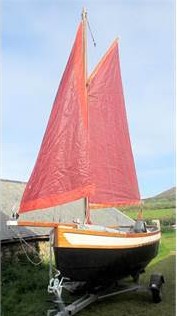
Lady Blue
Lady Blue is a 16ft Jolly Boat, with 6ft beam plus 6ft bow sprit. She was built in 1996 under license from Giles Laurent classic boats no 109. She is gaff rigged with all classic bronze fittings and in a lovely condition. Owned by Phil and Zoe Manley of Lamorna.
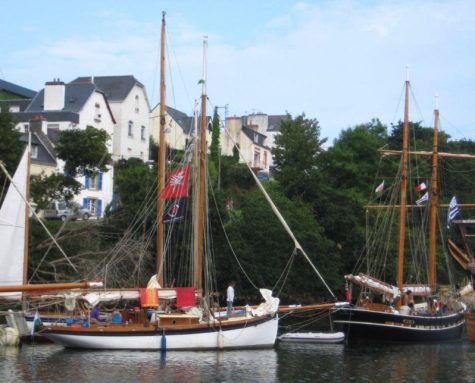
Lassie of Chester
Lassie of Chester is a 36ft Morcombe Bay Prawner, built by Crossfields in Conway in 1937. She is one of the last “Nobbies” to be built in this yard and fished the Dee during WW II and later in Fleetwood. In the 80’s she was left in the mud but was then restored by Scott Metcaff in Port Penthyn, Bangor. She has had periodic refurbishment, latterly be the present owners. She has sailed extensively, taking part in Classic Boat events in Britain and France. The present owner is Arian Farey of Abergele, Conway, North Wales. Lassie appears in the list of Historic Boats.
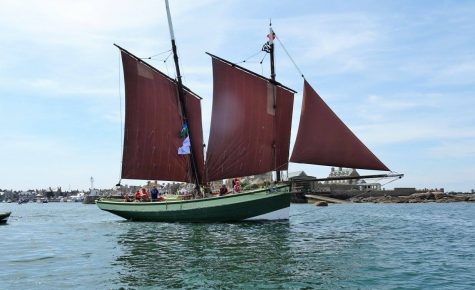
Le Grand Léjon
Le Grand Léjon is based in the port of St Brieuc in Brittany, France. She is a 48 footer, with a Breton Standing Lug rig and built in 1991 by Yvon Clochet of Beg Melen, River Treguier. She’s an exact replica of the 1896 vessel, La Jeanne d’Arc and in 1992, won the top award at the Brest and Douarnenez Festivals as the most authentically reconstructed vessel. She’s now used for charter and educational cruises.
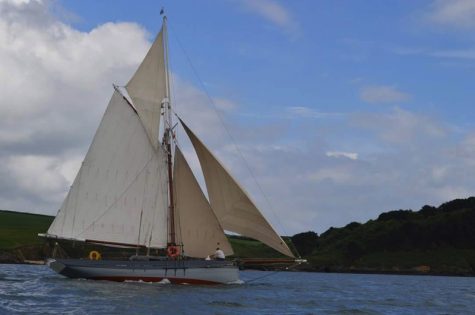
Lizzie May
A well-known writer on traditional sail and a former owner of pilot cutters, Tom Cunliffe, wrote of Lizzie May “To lay amongst these timbers listening to the sea rushing past is to feel seafaring’s lost heartbeat”. At 42′ long, she’s a beautiful replica of a pilot cutter of the mid to late 19th century, with her design inspired by the historic craft of the Isles of Scilly.
Lizzie May was the second creation from the acclaimed boat builder Luke Powell, originally taking 20 months to build her in 1998, then refurbished in 2001. Working pilot boats in the age of trading sailing ships had to have a reasonable degree of comfort below deck, so that the pilot would be fresh to take over a ship after spending perhaps several days aboard his pilot cutter ‘seeking’ a seagoing trading ship to see safely to its destination. Lizzie May’s accommodation, deck and rig are true to pilot cutters in the golden age of trading sail and her ambiance is widely regarded as authentic. She is a little gem, a lovely boat to sail, handles like a dingy, proving very smart in confined waters and easy to manoeuvre being so well balanced.
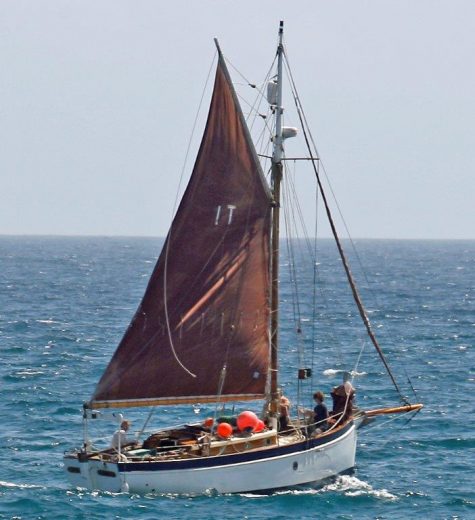
Luke’s Minnie
Luke’s Minnie – ‘Minnie’ was built on Channel Pilot Cutter lines by Luke of the Hamble in 1893 as a gentleman’s yacht. She was commissioned by Charles Harry Card of Vodoss House, Banister Road, Southampton who registered her at Lloyds on 28th March 1893 and claimed his occupation to be ‘gentleman’. It is known that she has remained in commission as a private yacht ever since, more or less, and each owner has continued her registration .
On the 14th of April 1966 she was sold to an American subject, who allowed the registration to lapse until 1973. The vessel was then purchased by Reginald McKern (the actor – Rumpole of the Bailey) who immediately re-registered her, but this time as Luke’s Minnie. He has recently revealed photos from his time as owner.
Her cut away forefoot must have been an advanced feature in her era and her heavy scantlings were typical of the period. She spent most of her life in the English Channel but with one period of over 20 years based in Belfast around WW2. Recent research by Tom Cunliffe’s daughter has produced interesting reminiscences from the Belfast owner’s family. The earliest available photo shows her under sail during this period with a larger rig.
In 1977 she spent 4 years cruising Europe and the Caribbean before arriving in the USA in 1982. She crossed the Atlantic in 17 days. During this period she was owned by a shipwright who extensively repaired and refitted the hull, including adding the double diagonal mahogany skin; this was epoxied to repaired planking after haul-out and drying out on a Florida beach .
In 1989 she was then brought back to UK for further restoration by Richard Jordan who took care to retain much of the original panelling, the whole interior being restored to match to provide a practical cruising vessel, with modern electrics, plumbing, navigation and a new 35HP YANMAR diesel with a 3 bladed propeller which produces adequate power in all conditions. Under sail she is very comfortable and safe as one would expect with 10 tons displacement, but she also has a good turn of speed. Minnie has been raced successfully, especially around Cowes where she achieved first place in her class in the 1992 Round the Island Race and second place in 1993 and 1994.
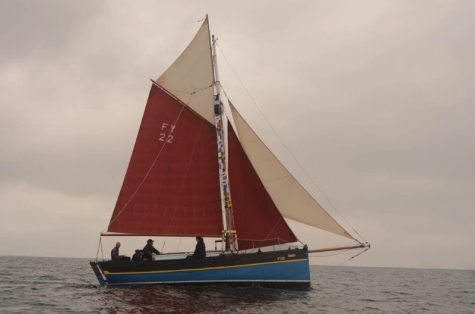
Maggie
Maggie is a 30 ft Polperro Gaffer, built in Looe in 1908 by Ferris for the Searle Family. She was later fished by Wren Jolliff who was the Great Grandfather of the present owner. Dave Cowan found her in Hey Bridge basin and she is now back after a 70 year absence.
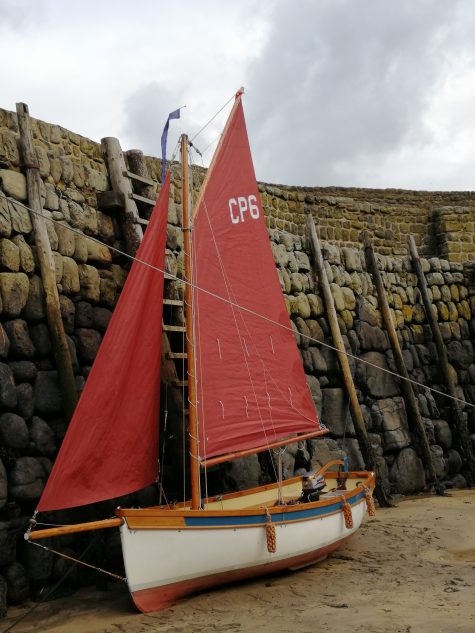
Mallard
Mallard is an 18ft Clovelly Picarooner built in 1984 by Terry & Martin Heard of Mylor. She is number six built. Lines were taken from the Picarooners used for herring fishing in and around Clovelly. These smaller vessels were used in order to land the catch earlier than bigger fishing boats, hoping to secure the best prices! There is a rumour that the original boats were based as ships boats, found after foundered Spanish galleons from the Amarda. But there is only anecdotal evidence for this. The name comes from ‘sea robber’ or ‘pirate robber’, a name given no doubt by the owners of the larger craft that had to wait for the higher tide before they could land their catch! At the height of the herring fishing, there were over fifty Picarooners fishing from Clovelly. The rig is much modified by Malcolm Gorram, the present owner. There’s a longer bowsprit, more rudder area and 20% more sail. There’s even a less intrusive outboard, set within an inboard well.
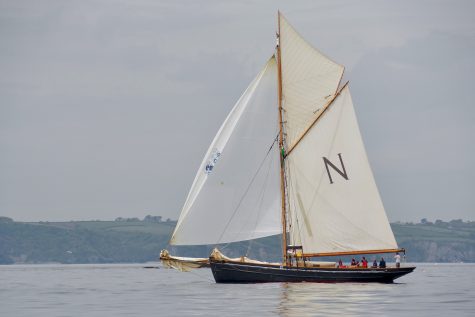
Mascotte
Mascotte was built in 1904 by Thomas Cox & Son in Newport, Wales. After completion, Thomas became her owner and a Bristol Channel Pilot. At 65ft, Mascotte is believed to be the third largest Bristol Channel Pilot Cutter ever built. She was twice as heavy and 10ft longer than most others and now, the largest surviving. Built to be seaworthy, sea kindly and fast, she made Thomas Cox a wealthy man. She once even sailed around Lands End to Dover to pick up a ship bound for Newport. The opulence and Edwardian grandeur below deck was reflective of how successful the Pilots were and more importantly, how they liked to live at sea. Mascotte was completely refitted at T Nielsen & Co, Gloucester in 1994. She now runs a variety of voyages, day trips and sail training, including work for the newly formed charitable organisation ‘Rich’s Boat’, formed in memory of her previous skipper, Rich Clapham. Owned by Mark Tyndall and based from Charlestown Harbour, Mascotte is now prioritising the provision of meaningful and life changing experiences on the sea.
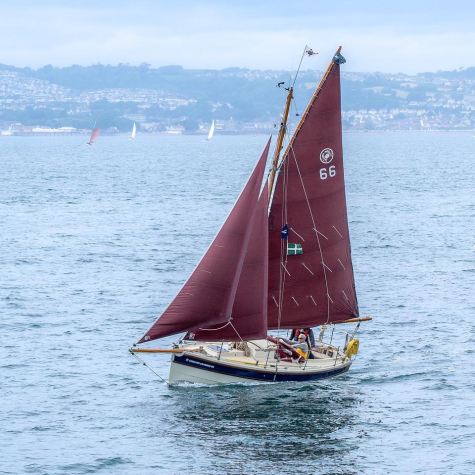
Mischief
Mischief is a modern 22ft Cornish Crabber owned by Sue and Mike Garlick. As Mike humbly says, she’s not in line with the genuine vintage boats, but in the Spirit!
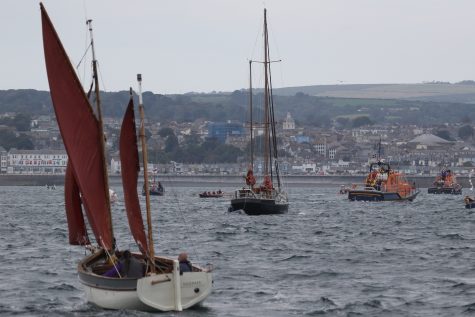
Mispah
Mispah was built by Gary Mitchell of Percy Mitchell & sons in 1982. She is 20’’ 7’ and constructed of English oak and elm with Larch planking. She has a standing lug mainsail, a lug mizzen and jib, referred to as a Mevagissey Tosher rig. She draws about 3ft and has legs. Owned by Jamie Palant, she’s sailed from Newlyn Old Quay.
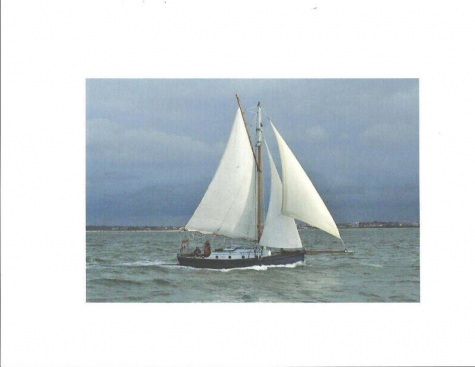
Molly Oxford
Molly Oxford is a Heard 28’ Gaff Cutter from Gaffers & Luggers Mylor and completed by Robertsons of Woodbridge in 1989. The current owner is Chris Lane, who was brought up in Penzance and now sails out of Chichester Harbour in West Sussex. Molly Oxford participated in the Falmouth Classics and the Brest & Douarnenez Festivals in 2016.
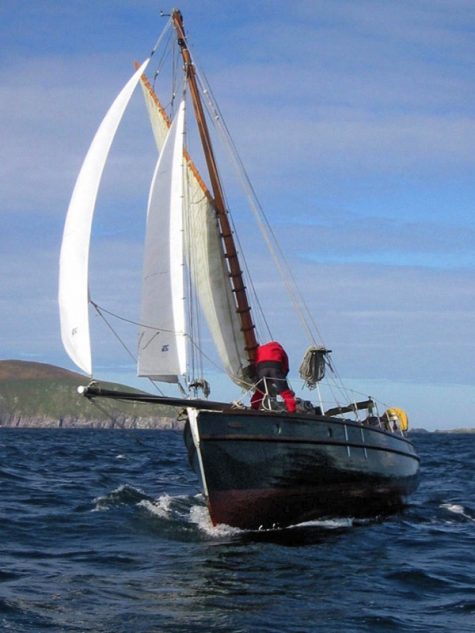
Moose
Moose was built in 1925 by Pearns and Son of Looe. She was originally known as Moby Dick, owned by Looe Harbour master and used for Shark fishing. She’s pitch pine on oak, 32ft long and a classic Looe Lugger. During WW2, she was one of many vessels commissioned by the MOD, to repatriate troops from Dunkirk. But only a handful of Cornish boats went in the end. She was converted to a Gaff Cutter in 1990 and from then, sailed extensively the West Coast of Ireland, Scotland and the South West of England. We’re very excited to see her now owned by a Mousehole resident.
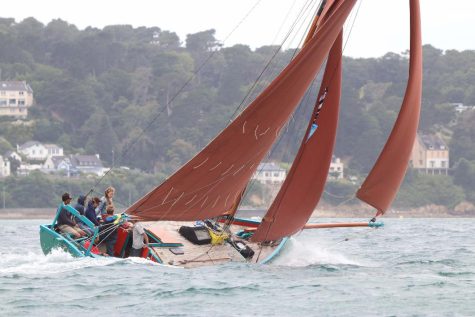
Mousehole
Mousehole is a stunning 28ft Heard owned by Dimitri Muller and now forms part of the ‘Glaz Project’ based from Saint Malo, Britany. The project aims to link a diverse range of maritime education, through community, boatyards and cleaner carbon-free sail cargo.
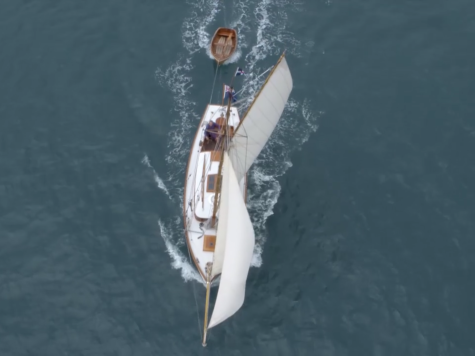
Nightfall
The 31ft Nightfall is a gaff cutter built in 1910 at Oulton Broad, Norfolk by Frederick Miller. She was an auxiliary shoal-draft cruiser design by naval architect, Harold H Lidstone, based in Cowes (Isle of Wight). Originally named Nautilus, she was constructed to a high price for the time (£610) by a yard used to orders for fine ship’s boats. Particularly, for London and Wivenhoe-based steam yacht designers, Cox and King, as well as yachts and Norfolk Broads hiring cruisers. Miller’s daughter Philippa (“Pippa”) became a much loved Broads artist.
Unusual for the times, Nautilus was fitted from new with a 6hp single cylinder 2-stroke petrol auxiliary motor. This was made locally by Boulton & Paul, who were later better known as aircraft builders. The motor was offset to port in the cockpit, belt driving, then a central shaft with a very modern aperture sited propeller. Her commissioning owner WD Silcock of Waveney Sailing Club, Oulton Broad, wanted a finely fitted yacht, capable of being sailed comfortably by him and his wife on both inland and coastal waters. This is how she has continued to be used by a succession of owners to the present day.
Her second owner from 1931, was small boat designer, writer, journalist and luminary, Maurice Griffiths. From here, we are afforded a remarkable insight into Nightfall, as Griffiths renamed her. After 21 years, she was still in fine condition. In a chapter devoted to Nightfall in his 1933 book ‘Ten Small Yachts and Others’, written on board, along with ‘Magic of the Swatchways’, Griffiths describes her in great detail. Also detailed, is the thrill of becoming the owner of such a finely fitted out yacht. Summing up yachts of her ilk he wrote: “These little ships are as desirable as the moon, and about as elusive – bless ’em!”

Norwegian Girl
Norwegian Girl, a Skanner 19 was built in 1982 by Mike Hawes of Devoran. She is the first of type and originally Bermudan rigged with an aluminium mast. She was also the subject of an article in the PBO in 1984. Early in her life, she was converted to a gaff rigged cutter with a short bowsprit and fitted with a direct drive Dolphin petrol diesel inboard. The present owner, Malcolm Goram has modified the rig by raising the gaff to a high peak, lengthened the bowsprit, increased the rudder area and design and re-engined with a Bukh 10 diesel inboard. She has also recently undergone an extensive internal refit.
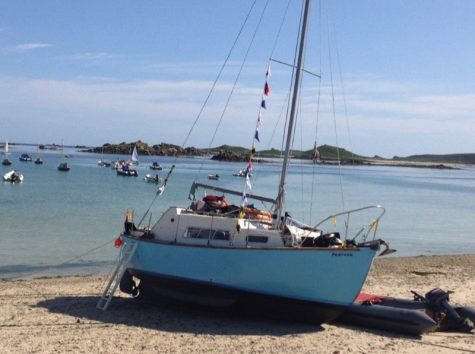
Pedrosa
Pedrosa was built in 1963 at Fairey Marine, Hamble, Southampton. She is a 28ft sloop rigged motosailor. Hot moulded Agba (mahogany) on pitch pine frames. Her owner Andy Wheeler keeps her in Penzance.
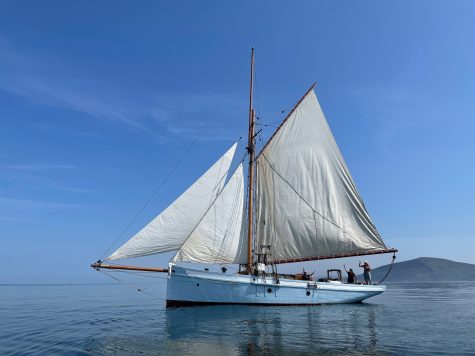
Peggy
Peggy is a 44ft Bristol Channel Pilot Cutter and was built in 1903 in Pil by Edwin Rowles for Richard A Case. In her day, she worked for a few Pilots, eventually sank but was restored in the 80’s and then owned by the Pridies until 2018. She now sails out of Bristol and owned by John Potter.
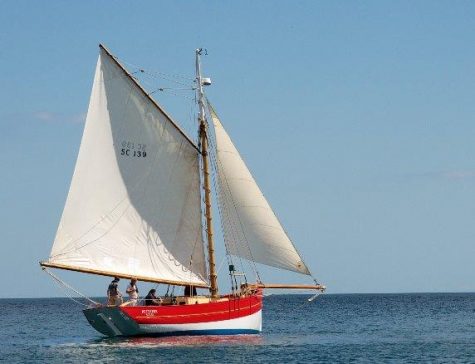
Pettifox
Pettifox was built in 1992 by Peter Martin and Alfie Hicks and is the last sailing boat to be built on the Isles of Scilly and is still registered (SC 139). With 1,000 sq feet of sail, she’s a 36ft Gaff Cutter with a good turn of speed. Owned and skippered by the very likable Johnny Barley, she’s used for day sails and chartering from the Fowey area.
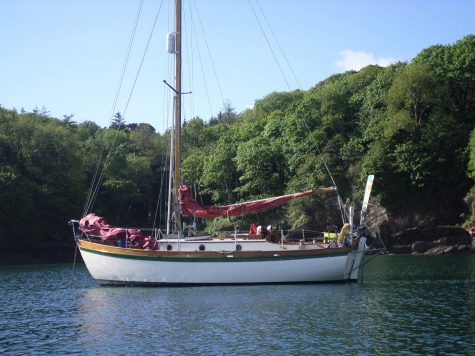
Pomona
Pomona is 27 ft Bermudan sloop, with 5.5 ft draft and a long keel with no legs. She is built from mahogany on oak in 1956 and designed by Collin Cowan, who worked in the Laurent Giles office. Her last owner circumnavigated the world and made 5 Atlantic crossings in her. Now that’s a talking point for a small vessel. She is now owned by Danny Rocca.
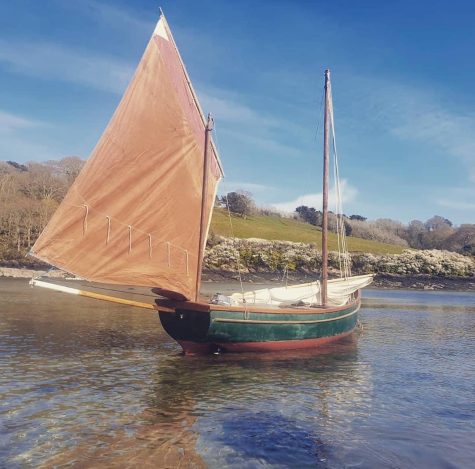
Precious
Precious is an 18ft traditional looking Clovelly Picarooner with a dipping lug rig. Built by Heards, she’s owned by Sam Coltman.
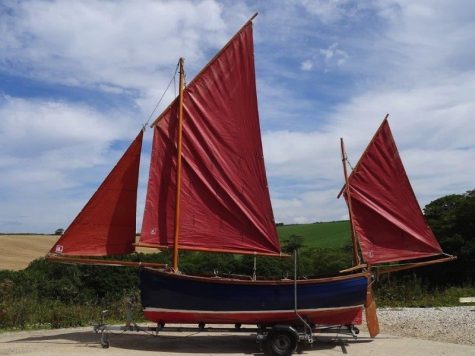
Rebecca Kate
Rebecca Kate is a 16ft Port Isaac lugger, built by students in Lowestoft in 2001 for the boat’s designer Martin Castle. She is based on the lines of a vessel sailed and fished out of Port Isaac by his grandfather, over a hundred years ago. She has a typical two masted lug rig with a bowsprit and boomkin. She is owned by Jonny Mills.
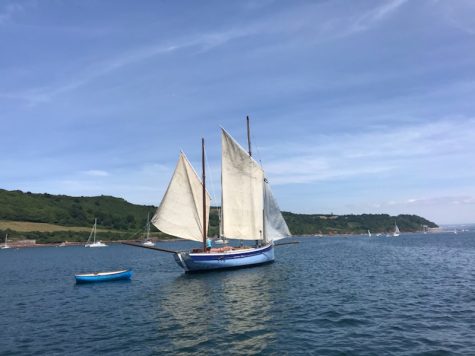
Reliance
Reliance (FY59) is a 38ft Mevagissey dipping lugger, built in 1903 by Dick Peal of Gorran Haven. She was built for the Hunkin family of Mevagissey and fished from here until 1948 when she moved to the Penzance registry as PZ290. She has a beam of 11′ 6″ and draft of 5′ 6″.She left the fishery in 1966 and like many luggers, she fell into disrepair but was discovered again in the late 1990`s in the Heards Yard near Falmouth. Rescued in 1998 by Deana Russell, she’s been fully restored between 2014 to 2018 by the current owner, Since then she’s cruised to Brittany and the Outer Hebrides. She is owned by Graham Butler and her home port is Cawsand, Cornwall.
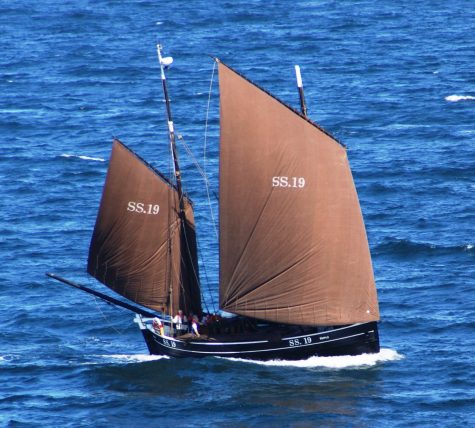
Ripple
Ripple was built in St Ives by Henry Trevorrow and registered as SS19 in 1896. For 25 years until 1933, she was used for fishing under the ownership of the Barber family. Her skippers were William and his brother Matthew. She was originally propelled by sail, with two lugsails carried on two masts. In 1915 this was boosted by the installation of a 16 hp port wing engine. She undergone a complete renovation a decade ago by the present owner John Lambourn and mainly sails in Mounts Bay.
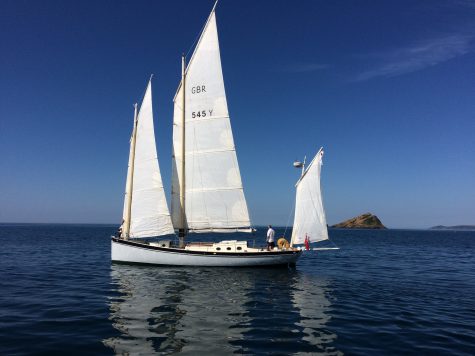
Roanna
At 36ft, Roanna is a modern 3 masted lugger, designed by Nigel Irens. With a modern take on the evolution of Westcountry fishing boats over the centuries, she was built in Staverton on the river Dart in 1999. She portrays a charming blend of old sea-worthy values with modern lightweight materials, with strip planked cedar hull and carbon fibre free standing rig. She will give any modern boat a run for their money, while visually retaining the charm of times long gone. Based on the River Yealm, she’s owned by Chris George.
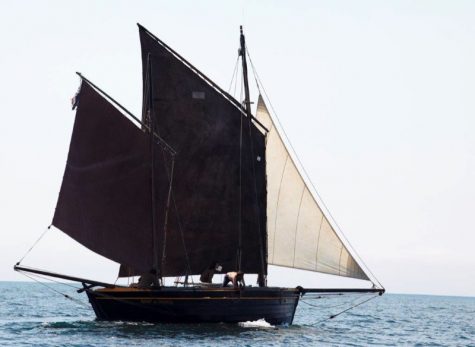
Rose of Argyll
Rose is newer than many luggers, though probably does the most sea miles than many combined. She was clinker built in Scotland and not in Cornwall. Her specific type is a Loch Fyne skiff and a replica of a herring boat from the early twentieth century. First sailed as a yacht, she was then abandoned in a garden in the Gulf of Morbihan in 1990. She was bought and restored and relaunched in 2009. Owned by Benoit and Elise, her home port is Lannilis, Aber wrach. The boat is skillfully handled under sail (as she’s engineless) and port manoeuvres are carried out by rowing and sculling.
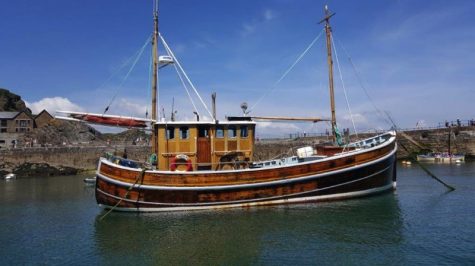
Seascan
Seascan was built by the famous Scottish yard Alexander Nobles and sons in 1962. She was a research vessel and finished her working life as a fishing boat. She is larch planking on oak frames and is powered by a 6lxb Gardner. Owned by Rob Greenway.
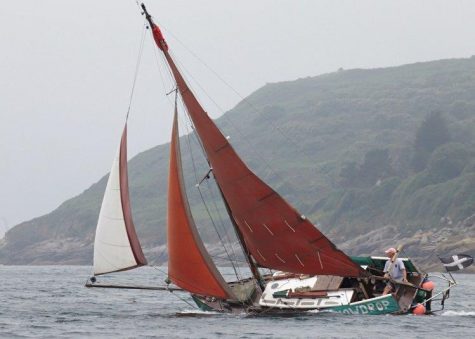
Snowdrop
Snowdrop is a tough little 22 foot Deben Four Tonner from the early 1930’s. With a beam of 8ft, a draft of 5ft and a 9ft bowspirit, she’s a beautifully balanced boat that sails around Mounts Bay for most of the year. Winning Sea Salts and Sail’s U23 foot class in 2014 and runner up in 2016, she’s now owned by Geoff May and sails out of Newlyn.
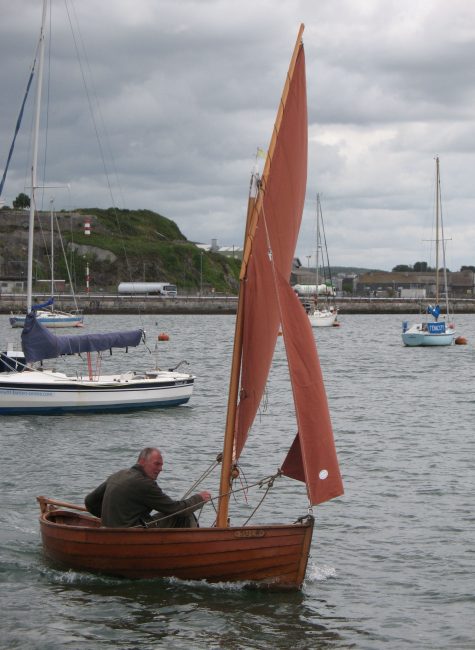
Sula
Sula is a Western Highland skiff built in larch on oak by Sandy McDonald in Ardnamurchan, Scotland in 1993. She also won the ‘Classic Boat’ amateur boat building competition at the Wooden Boat Show in 1993. She’s 11’3’’ long and owned by John Scott.
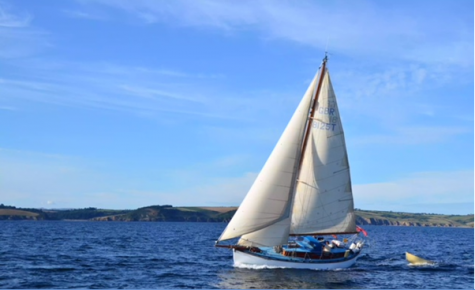
Trooper
Trooper is a 9 ton Bermudan Cutter, canoe stern and centre cockpit constructed in wood in 1959 by David Hillyard of Littlehampton. David Hillyard made his name boat building affordable wooden boats in between the 1920s and early 1970s. The 9 ton series was his most popular and Trooper was built in the heyday of the yard. Hillyards are known for their solid construction but not for their speed. She has a new rig designed in 2005 by the renowned marine architect Ed Burnett and sails beautifully. She is owned locally by the Guys and is used for local Helford cruising with all the family aboard.
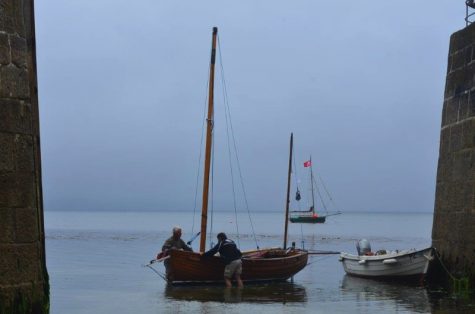
Twilight
Twilight was built as a motor boat by H J Mean & Son at Axmouth, Devon in 1973/4 and later converted into a Beer Lugger in 2005/6 by the present owner Alan Abbott. She regularly sails in the Beer Lugger Club Races, Beer Regatta, the Biennial Looe Lugger Festival as well as Sea Salts and Sail Festival. She’s a hard boat to beat!
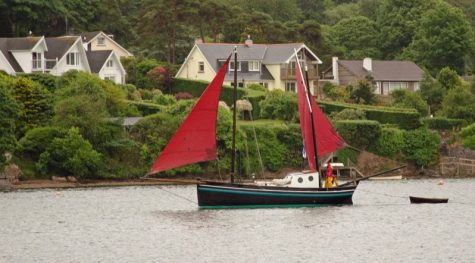
Veracity
Veracity is a stylish 32 ft dipping Lugger, built by Marcus Rowden in 2004. She is now owned by Holly Latham.
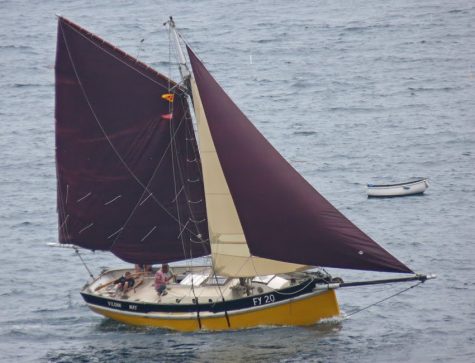
Vilona May
Vilona May is a 29ft Polperro Gaffer, built in Looe in 1898. She’s sailed across the Atlantic five times and has also sailed to Australia and Greenland. Now restored in Milford Haven, she’s owned by Andrew McCloud and based in Milford Haven.
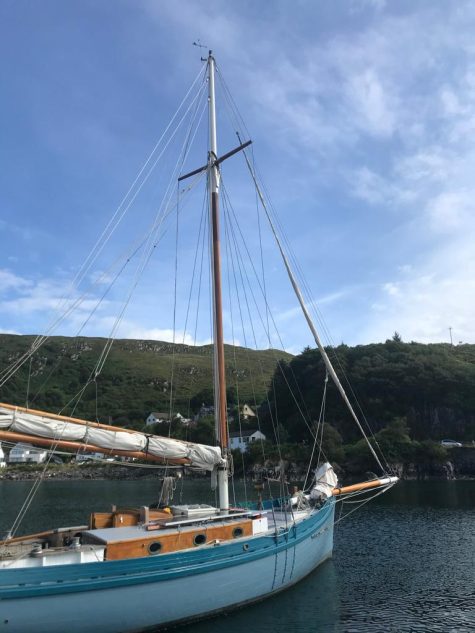
Wild
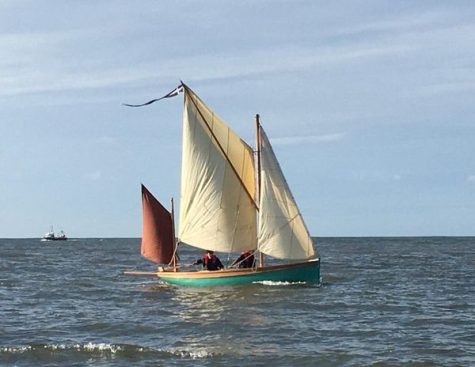
Wild Boy
Wild Boy is a wooden 17ft replica of an 1882 Gorran Haven fishing boat. She is a spiritsail yawl and built by Debbie Purser in 2020. With her near identical sister ship, Outdoor Girl, they were designed for inshore exploration, camping trips and making the most of wind, tide, sail and if all fails, ingenuity and oars.
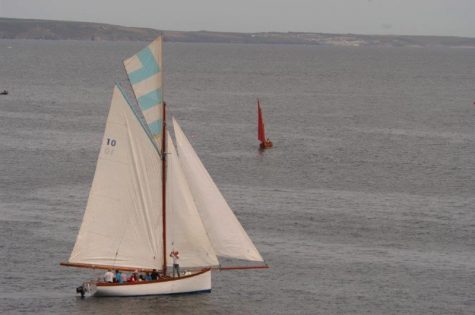
Winnie
Winnie was built in 1897, a 28ft Falmouth Working Boat and owned by Arthur Williams. We’re delighted to see her return (enginless (ish!) to this side of the Lizard for she’s an impressive sight under full sail. In a close hauled contest, there are few who cannot be inspired by the beauty of these powerful Gaff Rigged Cutters. Outwardly, little has changed in nearly 200 years for the FWB, which under the laws of local harbour byelaws, prohibits the dredging of oysters by any mechanical means.
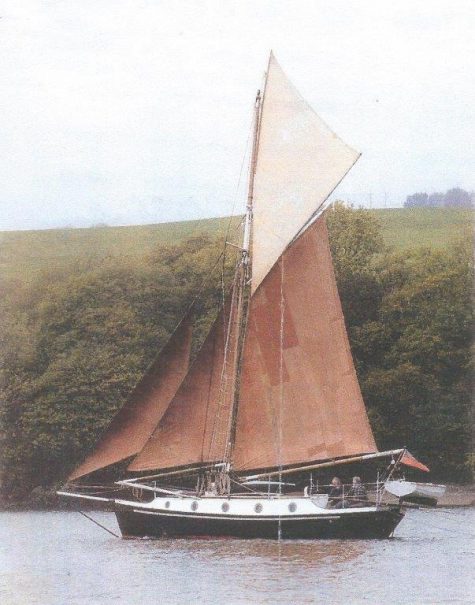
Wylo II
Wylo II is owned by Nick Skeates of Warminster and is a 32ft Centreboard Gaff Cutter. She was built in New Zealand in 1980 to the owners design. She has a steel hull, wood deck and has now circumnavigated 3 times, via the Atlantic, Pacific and Indian Oceans, Panama Canal, New Zealand and South Africa. Nick is a fantastic character full of soul, wisdom and experience. An honour to have him here.
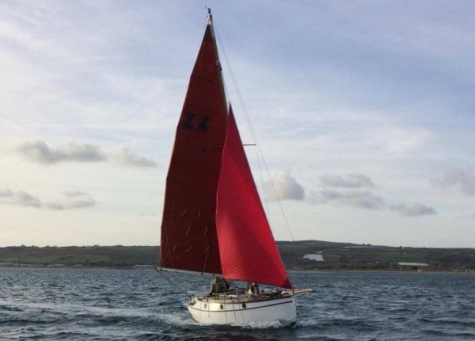
Zephon
Zephon was designed by Harrison Butler and built by the Probert Brothers, Swansea. The build started before WWII but as with many boats, this was put on hold during the war years and she was completed and launched in 1950. Until the late 1960’s she was owned by Mr D.G. Probert of Milford Haven. She is sail No. Z278. She is one of only 10 Zyklon class boats built as opposed to 52 of the Z4 Tonners. Her hull (pitched pine on bent oak) is to the standard Z4 design but she has raised topsides which hugely increases the interior volume of the boat. This alteration was designed by Cpt O.M. Watts and proved to be very effective. Sailed by Giles Gilbert (the present owner) from the Shetland Islands to Cornwall in 2016, since then she has been sailed around the Cornish coast and out to the Isles of Scilly. Currently sailed without an engine.


